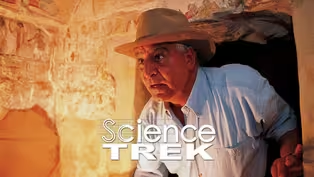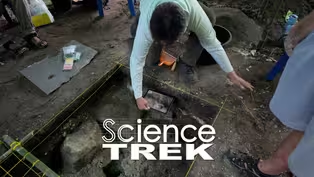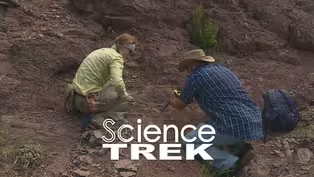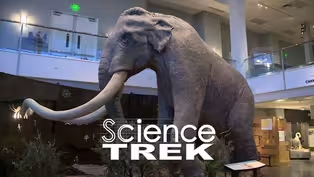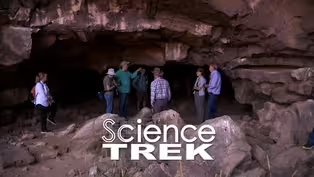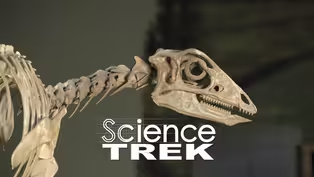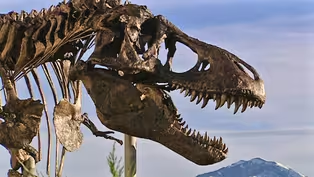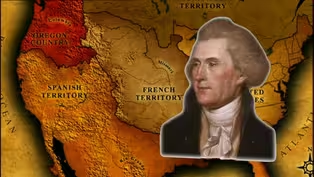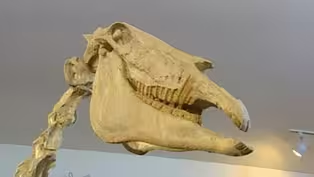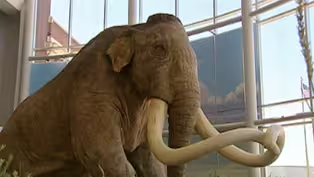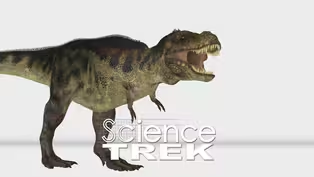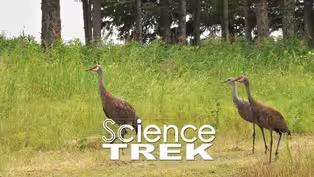
Dinosaurs: Dinosaur Basics
Special | 5m 42sVideo has Closed Captions
Meet Sue, the traveling T-rex.
Dinosaurs once dominated the earth. Find out more about these creatures and learn how folks at the Museum of Idaho put together the traveling version of “Sue,” largest, best-preserved, and most complete Tyrannosaurus rex ever found.
Problems playing video? | Closed Captioning Feedback
Problems playing video? | Closed Captioning Feedback
Science Trek is a local public television program presented by IdahoPTV
Major Funding by the Laura Moore Cunningham Foundation and the Idaho National Laboratory. Additional Funding by the Friends of Idaho Public Television and the Corporation for Public Broadcasting.

Dinosaurs: Dinosaur Basics
Special | 5m 42sVideo has Closed Captions
Dinosaurs once dominated the earth. Find out more about these creatures and learn how folks at the Museum of Idaho put together the traveling version of “Sue,” largest, best-preserved, and most complete Tyrannosaurus rex ever found.
Problems playing video? | Closed Captioning Feedback
How to Watch Science Trek
Science Trek is available to stream on pbs.org and the free PBS App, available on iPhone, Apple TV, Android TV, Android smartphones, Amazon Fire TV, Amazon Fire Tablet, Roku, Samsung Smart TV, and Vizio.
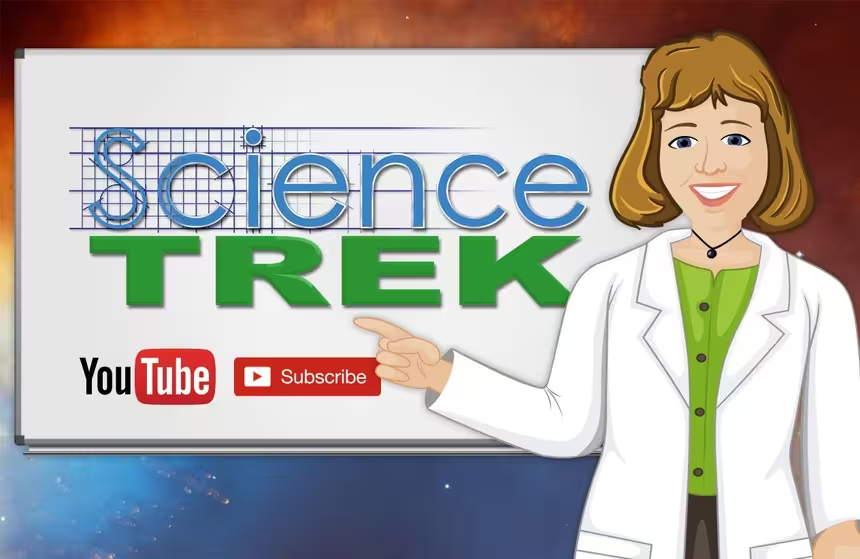
Science Trek
Science Trek is a place where parents, kids, and educators can watch short, educational videos on a variety of science topics. Every Monday Science Trek releases a new video that introduces children to math, science, technology, engineering, and math (STEM) career potentials in a fun, informative way.More from This Collection
Scientists study things left behind to tell the story of what happened in the past. Paleontologists look at bones to help us understand how ancient creatures once survived. Archaeologists and anthropologists study how people lived hundreds or even thousands of years ago. Find out more about what took place in ages past.
Archaeology: Digging into the Past
Video has Closed Captions
What does a mummy smell like when it is first discovered? (7m 16s)
Archaeology: PEMSEA Field School
Video has Closed Captions
Learn about the excavation process of archaeology as Dr. Peter V. Lape and his team dig up the past. (6m 29s)
Video has Closed Captions
What kind of dinosaurs are found in Idaho? (5m 44s)
Video has Closed Captions
Scientists think there were ten different species of Mammoths. What were they like? (5m 51s)
Mammoths: Archaeologist and Paleontologists
Video has Closed Captions
What kind of scientists study Mammoths? (6m 43s)
Skeletons: Just How Do They Know It’s A Dinosaur?
Video has Closed Captions
Paleontologists study skeletons to learn about ancient species. (6m 12s)
Video has Closed Captions
What does a dinosaur egg look like? Find out here! (28m 49s)
Video has Closed Captions
What did archaeologists learn about life in Egypt from King Tut’s tomb? (28m 57s)
D4K: The Science of Lewis and Clark
Video has Closed Captions
Lewis and Clark made major scientific discoveries on their journey West. What were some? (28m 49s)
Providing Support for PBS.org
Learn Moreabout PBS online sponsorship[MUSIC] Joan Cartan-Hansen, Host: Dinosaurs dominated the landscape for more than 160 million years.
Long before humans were around.
The first dinosaurs lived about 230 million years ago in what is known as the Triassic period.
Others came and went over the centuries, finally dying out about 65 million years ago at the end of the Cretaceous period.
What we know about dinosaurs we've learned from their bones and other fossils.
Scientists called paleontologists find, prepare, and carefully study each new specimen.
And what have they found out?
Dinosaurs started as small meat-eating animals.
They evolved into thousands of different types, including some of the largest animals to ever walk the earth.
Dinosaurs were meat-eaters and plant-eaters.
Some hunted their prey.
Others were scavengers.
One way scientists can tell what kind of food a dinosaur ate is by looking at their teeth.
The Tyrannosaurus or T-Rex had huge teeth, but it was probably a scavenger rather than a hunter.
Dinosaurs were not warm-blooded or cold-blooded, rather, scientists think they were dinosaur-blooded.
A condition sort of like being warm-blooded, but not exactly.
They laid eggs like birds and were good mothers, watching over their nests.
Some dinosaurs ran very fast, and there were avian dinosaurs that flew.
So why did dinosaurs disappear?
One theory is that an asteroid hit the Earth in the Yucatan Peninsula in Mexico.
The resulting explosion destroyed forests throughout most of North America and much of South America.
It would have caused an earthquake, and evidence of a giant tsunami has been found as far away as Spain and Brazil.
Those dinosaurs that survived the impact may well have died because their food supply was destroyed.
But not every dinosaur was wiped out.
Scientists think that one subgroup of the theropod dinosaurs evolved into birds.
Paleontologists continue to find and study bones and other fossils.
They are learning new things all the time, taking us back to the age when dinosaurs ruled the earth.
One way you can learn about dinosaurs is by looking at their bones.
The largest and best-preserved T-Rex on display is Sue at the Field Museum in Chicago.
There's a traveling version of Sue, and this is how they put it together.
[MUSIC] Woman: "The legs are in five and the tail is in three."
David Hanke: Travel Sue for Chicago is 36 total crates to put together.
Man: "You've got to have a screw in every hole before you tighten them up, otherwise they won't line up."
Hanke: It has a very large backdrop scrim that's on it.
It's a vinyl graphic that has a truss system, so that goes up first.
[MUSIC] Hanke: Once that's done, then we go ahead and we build the dinosaur.
So, we're going to do a leg, put the leg up by hand.
We're going to do the hip section with the lift, and then the other leg by hand again.
Man: "That's good, one, two, three."
[MUSIC] Hanke: These pieces we're handling are very heavy.
They're going to pick up into the air, you know, twelve and fifteen feet sometimes.
Man: "Push the knee backwards so that we can get it onto there, and come on baby, where's lady luck?"
[MUSIC] Man: "Walk it the other way."
Hanke: The real bones are just so precious to the museum, and they paid a lot of money for it.
So what we do have is then, is we had a team of fossil preparators that they made a mold of each and every bone of the entire dinosaur.
[MUSIC] Hanke: "Okay, hold the roof of the mouth and the nose and just steady the lower jaw.
Looking good, looking good, keep'er going."
Hanke: You're not going to see any armature holding up the dinosaur at all; it's all integrated inside the legs, and then it acts as a huge balance beam.
Man: "Ah, very good!"
[CHEERING] Cartan-Hansen: If you want to learn more about dinosaurs check out the science trek website.
You'll find it at ScienceTrek.org [MUSIC] Narrator: Presentation of Science Trek on Idaho Public Television is made possible through the generous support of the Laura Moore Cunningham Foundation, committed to fulfilling the Moore and Bettis Family legacy of building the great state of Idaho; by the Idaho National Laboratory, mentoring talent and finding solutions for energy and security challenges; by the Friends of Idaho Public Television; and by the Corporation for Public Broadcasting.
Video has Closed Captions
Clip: Special | 1m 4s | How much did dinosaurs eat? (1m 4s)
Video has Closed Captions
Clip: Special | 1m 4s | What did dinosaurs taste like? (1m 4s)
Providing Support for PBS.org
Learn Moreabout PBS online sponsorship
- Science and Nature

Explore scientific discoveries on television's most acclaimed science documentary series.

- Science and Nature

Capturing the splendor of the natural world, from the African plains to the Antarctic ice.












Support for PBS provided by:
Science Trek is a local public television program presented by IdahoPTV
Major Funding by the Laura Moore Cunningham Foundation and the Idaho National Laboratory. Additional Funding by the Friends of Idaho Public Television and the Corporation for Public Broadcasting.
